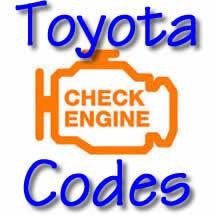Pull Toyota Codes without a scan tool
To extract DTCs from the computer for diagnostic purposes, the Self Test connector is used.
-
Turn off the engine and open the hood.
-
Locate the diagnostic connector in the engine compartment of your Toyota. It is usually found under the passenger side dashboard or in the fender. The owner's manual for your Toyota will have a diagram.
-
Attach the TE1 terminal to the E1 terminal with a jumper wire. Jumper wires are found at electronic stores and online.
-
Turn the key in the ignition to start the engine.
-
Watch and count the number of times the check engine light flashes. The light will flash in a pattern to indicate the two digit trouble code. For example, for code 53, the light will flash five times followed by a short pause and three more flashes.
96 & later are OBD2 systems and require a scantool Note: We are finding that some 94 & 95 Toyota vehicles are OBD2 compliant and require a scan tool. Check your emissions decal under the hood to confirm if you have an OBD2 compliant vehicle.
-
Clearing trouble Codes
All trouble codes must be purged from the ECUs memory after repairing the faults. Otherwise, code(s) would remain in the ECUs memory indefinitely and would appear along with a new code in the event of a future problem. - Remove the EFI fuse (15A) for 30 seconds with the ignition switch OFF to clear any codes. It may take longer than 30 seconds, depending on ambient temperature (the lower the temperature, the longer the fuse must be left out).
- trouble codes can also be cleared by disconnecting the vehicle battery. However, other memory functions (clock, radio, etc.), will need to be reset.
- After the codes are cleared, road test the vehicle (as applicable for the fault) and recheck if any codes reset. If so, it indicates that the trouble area has not been repaired correctly.
Toyota DTC's (Diagnostic trouble Codes)Data link Connector (DLC)
OBD1 Codes 1 Normal Condition. 2 Air Flow Meter signal. 3 Ignition signal. 4 Engine Coolant Temperature Sensor signal. 5 Oxygen Sensor. 6 RPM signal (Crank Angle Pulse). 7 Throttle Position Sensor signal. 8 Intake Air Temperature Sensor signal. 9 Vehicle Speed Sensor signal. 10 Starter signal. 11 Switch signal. 11 ECU/ECM. 12 Knock Control Sensor signal. 12 RPM signal. 13 Knock Control CPU (ECM). 13 RPM signal. 14 Turbocharger Pressure. 14 Ignition signal. 21 Oxygen Sensor. 22 Engine Coolant Temperature Sensor signal. 23 Intake Air Temperature Sensor signal. 24 Intake Air Temperature Sensor signal. 25 Air-Fuel Ratio Lean. 26 Air-Fuel Ratio Rich. 27 Sub Oxygen Sensor signal. 28 No. 2 Oxygen Sensor signal. 31 Air Flow Meter signal (Vacuum Sensor signal). 32 Air Flow Meter signal. 34 Turbocharger Pressure signal. 35 Turbocharger Pressure Sensor signal. 35 HAC Sensor signal. 41 Throttle Position Sensor signal. 42 Vehicle Speed Sensor signal. 43 Starter signal. 51 Switch signal. 52 Knock Sensor signal. 53 Knock Sensor signal. 54 Inter-cooler ECM signal. 71 EGR System. 72 Fuel Cut Solenoid signal. 78 Fuel Pump Control signal. 81 TCM Communication. 83 TCM Communication. 84 TCM Communication. 85 TCM Communication.


Ask a Mechanic
Free Insurance Quotes
Car Owners Manuals
Auto Wiring Diagrams
Auto Repair Manuals
Auto Repair Estimates
Hybrid Cars
Nut & Bolt Measuring Charts
Mechanic's lien Form







